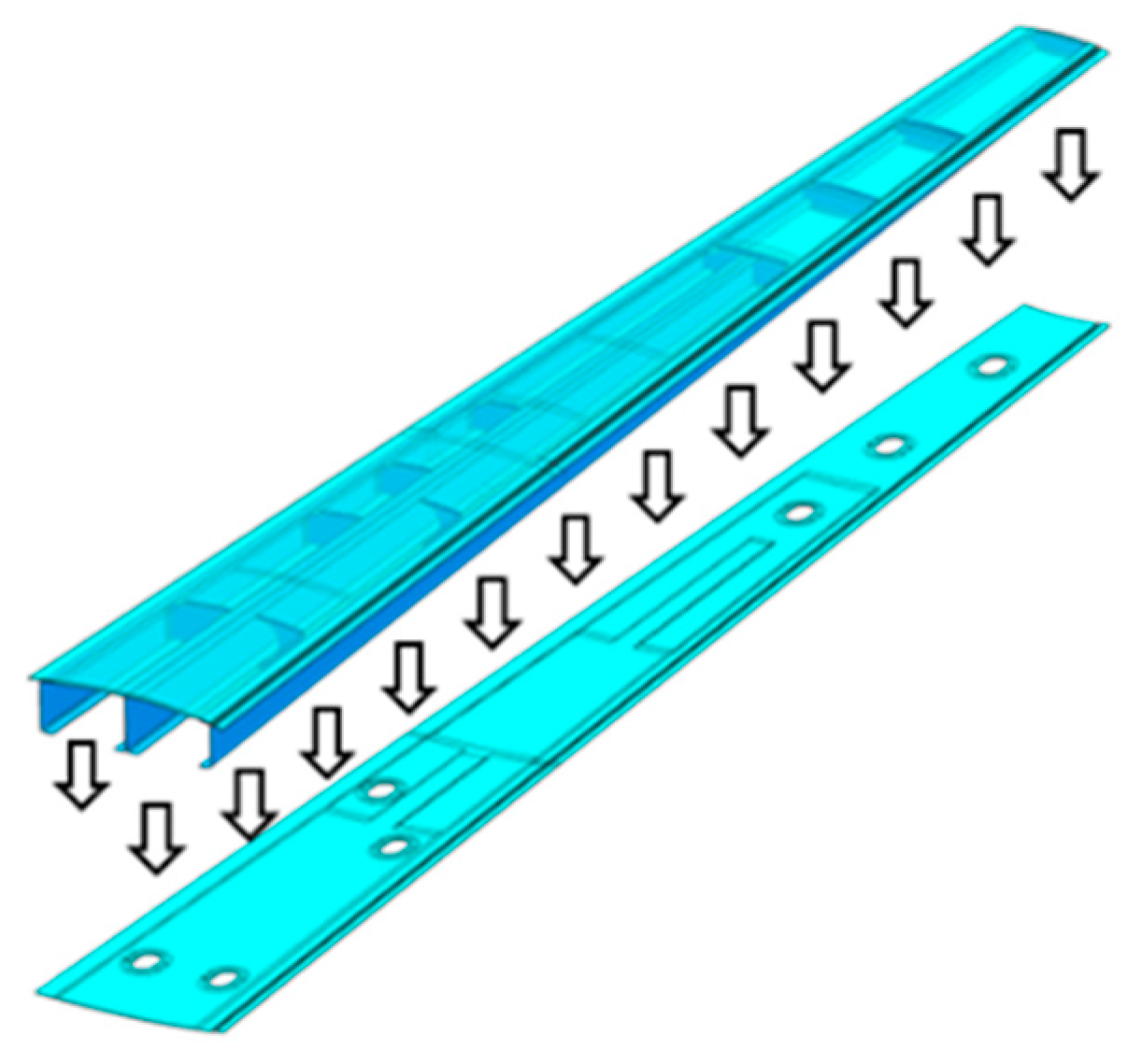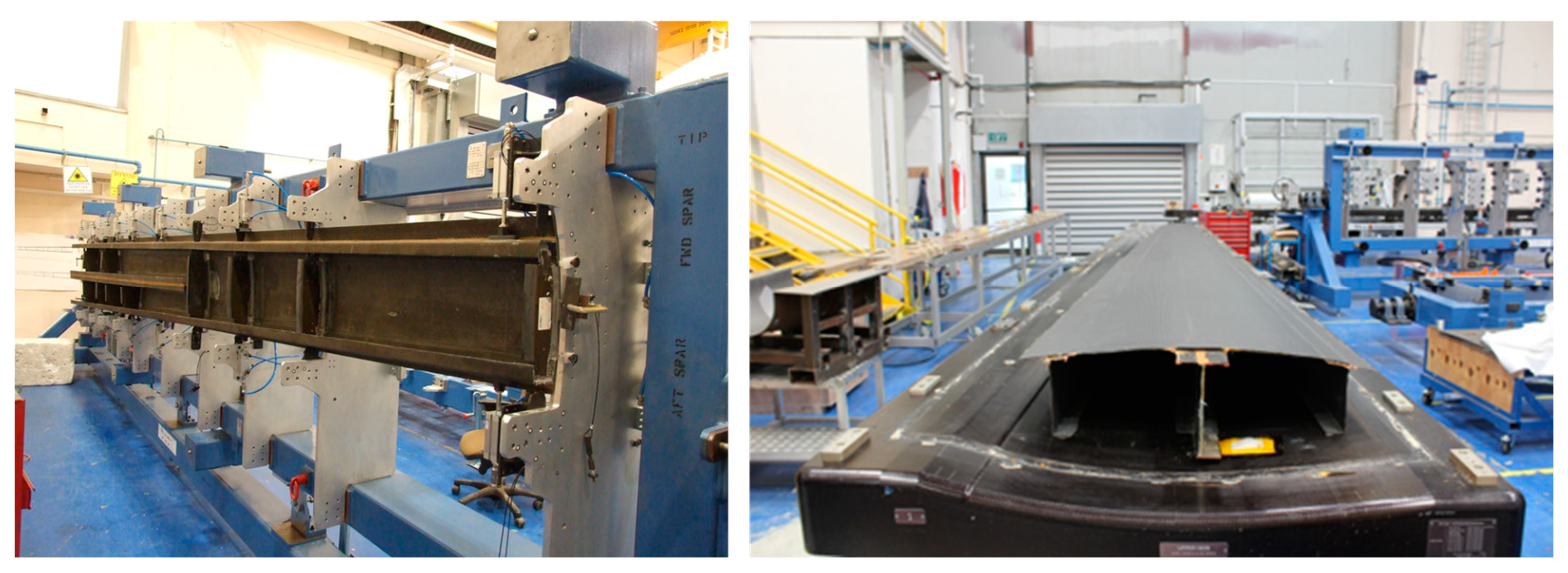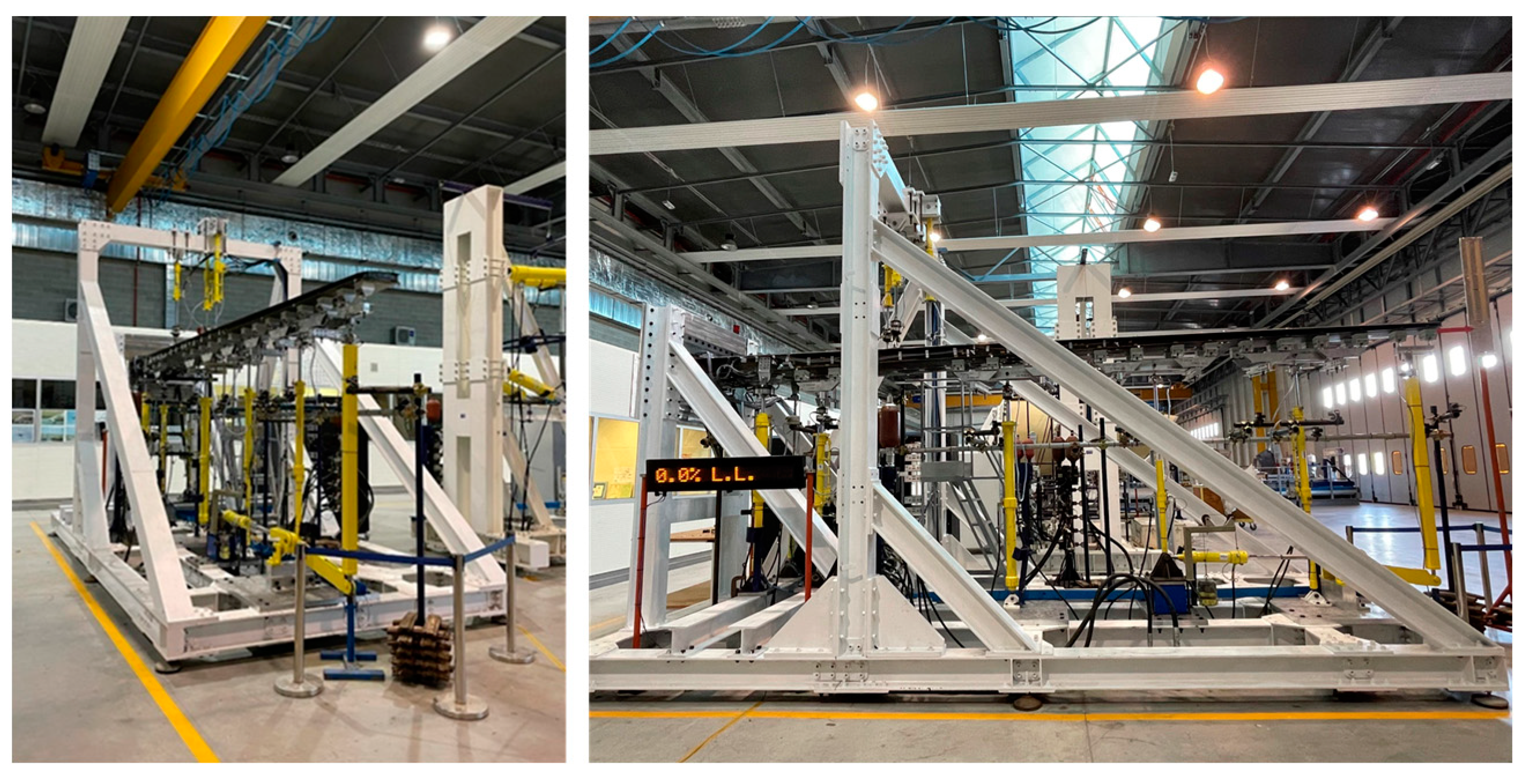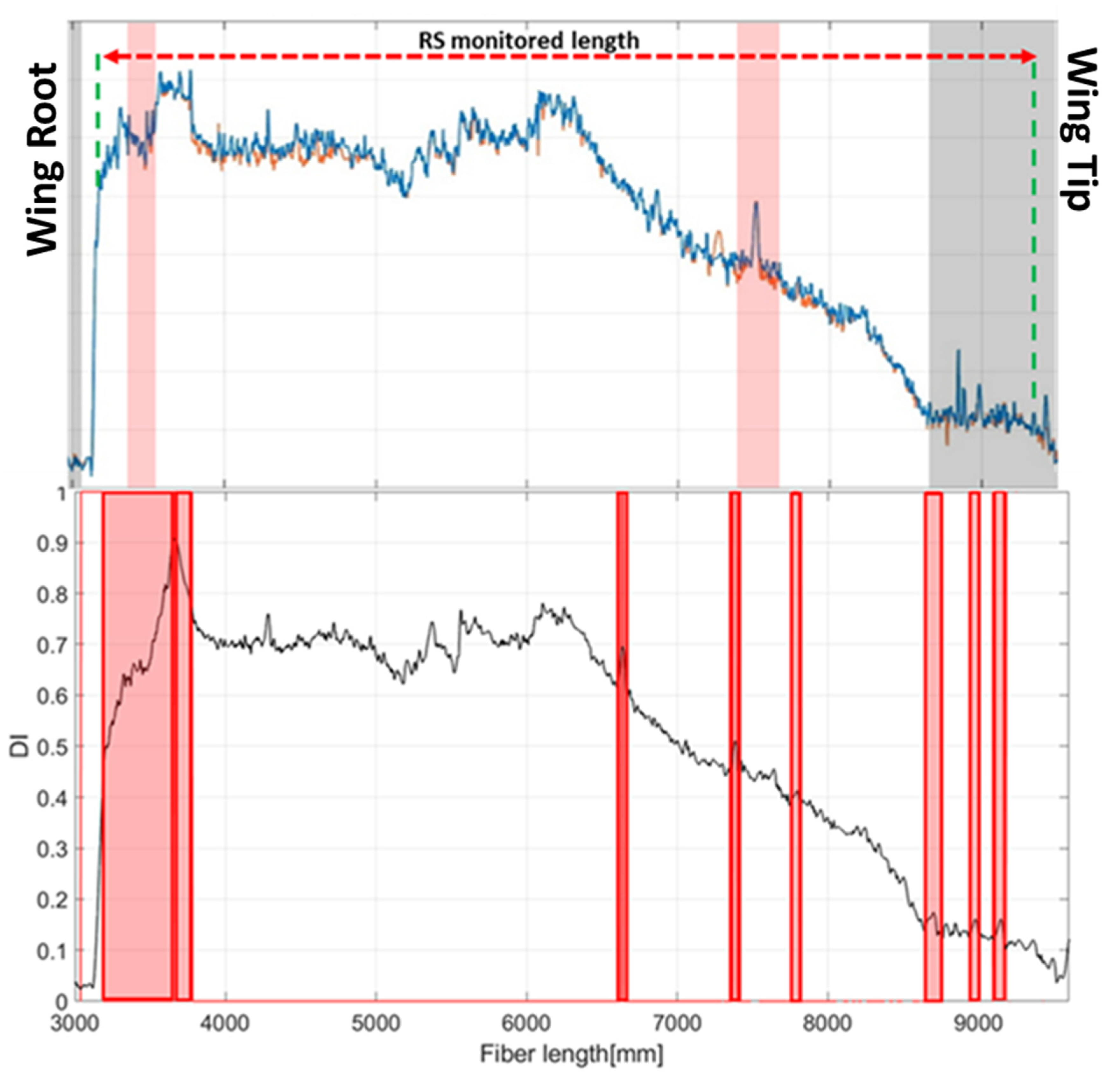1. Introduction
Recent years have witnessed a significant rise in the utilization of optical fiber-based Structural Health Monitoring (SHM) systems within the aviation sector [
1]. Fiber Bragg Gratings (FBGs) and Distributed Optical Fiber Sensors (DOFS) have emerged as leading technologies for monitoring critical aircraft components. FBGs, while highly sensitive to strain and temperature, enabling precise damage detection and localization, are limited by their point-wise nature when monitoring large-scale structures [
1]. In contrast, DOFS provide continuous monitoring along the entire fiber length, facilitating comprehensive assessments of structural integrity [
2]. Although significant advancements have been achieved, challenges such as cost, reliability, and the complexity of data analysis persist. Ongoing research endeavors are focused on addressing these limitations and fostering the widespread adoption of optical fiber based SHM systems in the aviation industry.
The Clean Sky 2 program, dedicated to developing innovative technologies to mitigate the environmental impact of aviation, encompassing the SAT (Small Air Transport) initiative. This initiative aligns with the research and development objectives of European small aircraft OEMs for passengers and cargo transportation, operating under the EASA’s CS-23 regulation. Within this context, Piaggio Aerospace and CIRA (Italian Aerospace Research Centre) have matured a novel SHM system that is poised to play a pivotal role in ensuring the safety and reliability of bonded composite aircraft primary structures. This study introduces an original SHM architecture based on DOFS, specifically designed to monitor bonding lines in small business commuter aircraft composite wings, with the aim to enhance safety, reduce maintenance costs, and optimize the design process by providing information on the structural integrity. The overarching goal of this work is to validate the proposed SHM system through rigorous ground testing, assess its Technology Readiness Level (TRL), and ultimately pave the way for its integration into full-scale aircraft. This research directly contributes to the advancement of optical fiber based SHM technologies within the Clean Sky 2 framework, addressing the need for reliable and efficient monitoring solutions for the evolving needs of the small aircraft industry.
2. Materials and Methods
The novel SHM system presented in this study utilizes distributed optical fibers and a proprietary algorithm, developed by CIRA, to detect damage in bonding lines [
3]. The SHM system, integrated within the ‘spars-lower skin’ bonding lines of the full-scale P180 composite aircraft wing box [
4], developed as part of the Clean Sky 2 OPTICOMS project [
5], underwent testing under operational static loads to validate its ability to detect damage. Ground testing procedures involved the application of diverse loading levels and the subsequent monitoring of the SHM system’s response. In detail, the two enabling technologies that concurred with the full-scale ground demonstrator are
Piaggio Aerospace contributed to the composite wing design and performed at its laboratories the experimental phase, setting up the test rig and the equipment needed for the static test.
2.1. The Approach
First, let us elucidate the rationale behind the adoption of the SHM system for aircraft primary bonded composite structures, as alternative to the conventional so called “chicken fasteners” technique. According to the airworthiness Certification Specifications, for bonded joints, CS 23.573(a)(5) states [
6]
“[…] for any bonded structure, the failure of which would result in catastrophic loss of the airplane, the limit load capacity must be substantiated by one of the following methods:
(i) The maximum disbonds of each bonded joint consistent with the capability to withstand the loads in par.(a) (3) (i.e., critical flight loads considered ultimate) must be determined by analysis, test, or both. Disbonds of each bonded joint greater than this must be prevented by design features; or
(ii) Proof testing must be conducted on each production article that will apply the critical limit design load to each critical bonded joint, or
(iii) Repeatable and reliable non-destructive inspection techniques must be established that ensure the strength of each joint.”
Considering the preceding point (i), the proposed approach was to integrate an SHM system as a design feature capable of monitoring disbonds within primary composite aircraft structures, thereby mitigating the risk of catastrophic failure. While the solution outlined in point (ii) may not be immediately practical for the aviation industry, further research into developing a technique akin to non-destructive testing (NDT), potentially even for on-board applications (point (iii)), presents an intriguing avenue of exploration.
2.2. Full-Scale Composite Integral Wing Box
Current methods for producing composite structures in the CS23 aircraft class are often inefficient due to low process stability, material limitations, and high labor costs. While automation can improve these issues, it is often not cost-effective for low-volume production. The OPTICOMS project developed a successful approach to address these challenges by integrating advanced technologies, innovative design concepts, and automation to reduce costs throughout the entire development and production process.
To be more quantitative, OPTICOMS attained the specific goals:
Reduction in composite design and certification costs (including testing) of about 30% for primary structures.
Reduction in composite production costs of about 40% for primary structures.
Reduction of structural weight of about 20% with respect to metallic reference wing box weight.
Reduction in overall life cycle costs of the aircraft of about 20%.
The main output of the project is a full scale 7 m wing produced with the down-selected optimal design, material system and manufacturing technology to realize the ambitious goals of the project. In detail, the wing box consists of two main parts: an integral structure made by co-cured upper skin to three spars and a lower skin panel bonded to the integral structure along spar caps, as shown in
Figure 1.
Dry preforms have been manufactured using Danobat’s automated dry material placement (ADMP) system, with non-crimp fabric (NCF) from SAERETX. The two previously described parts have been consolidated with liquid resin infusion (LRI) using RTM6-2, cured out of autoclave, and assembled with bonding by Israel Aerospace Industries (IAI). The manufactured composite wing box is shown in
Figure 2.
2.3. SHM System with Embedded Optical Fibers
Within Clean Sky 2 AIR ITD framework, CIRA developed, matured, and tested an innovative SHM system, based on an algorithm named L.H.E.O. (Local High Edge Observer), implemented in Matlab™ code (v.8.2.0.29), to detect damage size and location without the need for load and reference strain signature [
7]. The main physical effect to be exploited in the proposed methodology, is the local high signal scattering generated by a structural discontinuity, between sensors passing nearby or through non-damaged and damaged areas. Scattering is processed as a local edge detection technique typically used in image processing, based on the first order derivative [
7].
To compensate for the background random noise that may hide small deviations, a data filtering technique is also integrated. To this scope, cross-correlation function is applied to the first derivative signals with a general improvement in the signal quality.
The SHM system is composed of four main parts listed below and shown in
Figure 3:
Fiber optics (distributed fibers, interrogator, and associated optoelectronics)
Data elaboration and data filtering software
L.H.E.O. algorithm module
User interface module
The test article was supplied to Piaggio Aerospace’s Lab with ten optical fibers already installed by IAI: eight fibers embedded in bonding lines and two deployed externally, on the bottom skin. SHM system is schematically reported in following figure.
2.4. SHM Algorithm Methodology
The SHM methodology under discussion is predicated on the L.H.E.O. algorithm [
8]. This algorithm is meticulously designed to ascertain both the size and location of damage within bonded structures, without necessitating load information or a reference strain signature. This innovative approach is particularly pertinent for the detection of anomalies in bonding lines, such as poor bonding, debonding, and the notably elusive kissing bond.
The methodology can be delineated as follows: the L.H.E.O. algorithm capitalizes on the principle that structural damage induces local signal scattering within the strain distribution between adjacent sensors. In essence, regions afflicted by damage will manifest a distinct strain profile when juxtaposed with undamaged regions.
To facilitate this, distributed optical fibers, which provide dense spatial resolution, are embedded along the bonding lines or the surface of the structure. These fibers, in conjunction with optical interrogators, are employed to capture strain data at elevated sampling rates. The raw strain data thus acquired undergo a series of processing steps aimed at enhancing the signal-to-noise ratio. This processing encompasses
First-Order Derivative: Calculating the first-order derivative of strain data in both temporal and spatial dimensions accentuate local strain variations, thereby highlighting potential damage areas.
Cross-Correlation: The application of cross-correlation functions to the derivative signals further mitigates noise and augments signal quality.
This comprehensive methodology underscores the efficacy of the L.H.E.O. algorithm in the realm of Structural Health Monitoring, particularly in the context of bonded structures [
8,
9].
3. Results
The static tests conducted on the composite wing box demonstrator, designed to mimic the Piaggio P180 Avanti EVO wing (see
Figure 4), yielded crucial insights into the SHM system’s functionality and the structural behavior under stress.
The composite wing box was secured to a test rig, simulating cantilever loading experienced during flight; vertical loads, representing aerodynamic lift forces, were applied to the wingtip using hydraulic actuators; and strain gauges and optical fibers were strategically positioned to monitor strain distribution.
Testing began with loads up to 20% of the Limit Load (L.L.) to verify the test setup and SHM system’s functionality. Subsequent loads reached 50% L.L., allowing for data acquisition and analysis of the structure’s overall behavior.
At 70% L.L., an unexpected change in the strain gauge readings at the wing root, specifically in the front and rear spars, indicated a change in stiffness. This change, observed as a slope variation in the linear behavior of strain measurements, pointed towards potential debonding or delamination near the wing root.
Visual inspection and NDIs confirmed debonding at the wing root, aligning with the strain gauge data. The damage was localized near the constraint points and did not extend to other monitored areas.
The SHM system effectively detected debonding. The system’s Damage Index (DI) increased from 20% L.L. to 70% L.L., indicating the growth of the debonding. In
Figure 5, the position and the extension of the damage areas along the rear spar bonding line are shown, represented by the red bands at 20% of L.L. (upper image) and at 70% L.L. (lower image) along the wing span. The estimated debonding length, based on the SHM data, has been confirmed by NDIs.
TRL Evaluation of the System
The TRL evaluation process was conducted through NASA/US AFRL (Air Force Research Laboratory) method [
10] to assess the maturity of the technology, focusing on areas such as modeling-testing synergy and operational environment definition. The software used for data analysis was version 3.2 of the proprietary SHM algorithm, and the computer code is available upon request. The AFRL tool consists of a series of structured questions whose answers allow us to arrive at a more solid definition of the target TRL. It allows for the subjective assessment of the state of achievement by several criteria, whose satisfaction is expressed in percentage. The questionnaire has been completed by seven researchers from Piaggio and CIRA.
The results indicate
TRL 4 (Component and/or Breadboard Validation in Laboratory Environment) was assessed at 90.8% completion. This high score suggests a good understanding of the system’s basic principles and a successful demonstration in a lab setting.
TRL 5 (Component and/or Breadboard Validation in Relevant Environment) was evaluated at 72.4% completion. This score indicates progress towards testing in environments closer to the operational setting.
TRL 6 (System/Subsystem Model or Prototype Demonstration in a Relevant Environment) reached 46.7% completion. This lower score highlights the need for further development and testing in realistic operational environments.
4. Discussion
The results of this study indicate that the proposed SHM system is a viable solution for monitoring bonding lines in composite aircraft wings. The system’s ability to provide updated information on structural integrity has significant implications for the aerospace industry, including increased safety, reduced maintenance costs, and improved design processes. The findings are consistent with previous studies on SHM systems for composite structures, although they offer a novel approach by integrating distributed optical fibers and a proprietary algorithm. This combination enhances the accuracy and reliability of damage detection, setting it apart from traditional SHM methods. Furthermore, the successful ground testing with a full-scale wing box validates the system’s practical applicability and robustness in real-world scenarios.
The TRL evaluation underscores the system’s readiness for further development and integration into full-scale aircraft. However, it also highlights areas that require attention, such as improving the synergy between modeling and testing and refining the operational environment definition. Addressing these areas will be crucial for optimizing the system’s performance and ensuring its successful deployment in the aerospace industry.
In conclusion, the proposed SHM system represents a significant advancement in the field of structural health monitoring for composite aircraft wings. Its ability to provide updated information on structural integrity, coupled with the potential for reduced maintenance costs and improved design processes, makes it a promising solution for enhancing the safety and efficiency of future aircraft.
System Performance: The novel SHM system demonstrated a high level of performance in detecting bonding lines damage during ground testing. The use of distributed optical fibers and the proprietary algorithm proved effective in identifying damage, which is crucial for maintaining the structural integrity of composite aircraft wings.
Technological Maturity: The TRL evaluation provided valuable insights into the maturity of the SHM system. The results highlighted specific areas for technological improvement, such as enhancing the synergy between modeling and testing and defining the operational environment more precisely.
Implications for Maintenance: The ability to monitor the structural state of the aircraft wing before and after operations offers significant benefits for maintenance. By moving from a scheduled maintenance approach to an on-demand approach, maintenance costs can be reduced, and the overall safety of the aircraft can be increased.
Design Benefits: The increased knowledge of the structural system’s behavior allows for the possibility of modulating safety coefficients. This can lead to design improvements and potentially lighter and more efficient aircraft structures.
Future Directions: Future research should focus on further integration of the SHM system into full-scale aircraft. Additionally, addressing the identified areas for improvement, such as enhancing the modeling-testing synergy and refining the operational environment definition, will be crucial for the system’s success.
5. Conclusions
The ground testing successfully demonstrated the SHM system’s ability to detect damage in bonding lines. The system provided accurate and reliable data, also confirming its potential for a future real-time monitoring upgrade of composite aircraft wing. The TRL evaluation identified specific areas for technological improvement, including the need for enhanced modeling-testing synergy and better definition of the operational environment. These findings suggest that the SHM system is ready for further development and integration into full-scale aircraft.
Summary of Findings: The SHM system effectively detected the damage, with the DI increasing from 20% to 70% Limit Load, indicating the growth of the debonding. The estimated debonding length, based on SHM data, has been confirmed by NDIs.
The SHM algorithm is not computationally expensive and can easily process data from a dense sensor network.
A TRL evaluation, conducted using the NASA/US AFRL method, revealed that the SHM system had achieved: 90.8% completion of TRL 4, 72.4% completion of TRL 5 and 46.7% completion of TRL 6.
Implications: The SHM system currently does not distinguish between different types of damage, such as manufacturing defects and damage caused by in-service loads.
The handcraft deployment of the optical fibers can induce background strains that can affect the accuracy of the SHM system.
The SHM system needs to be tested in a more realistic operational environment.
Overall, the sources indicate that the SHM system has the potential to significantly improve the safety and efficiency of aircraft design and maintenance.
Future Work: The continuation toward the SHM technology maturation should include: the refinement of the sensor bonding model to better account for interactions between fiber optics and bonding agents; the assessment of the temperature and hygrometry effects on the sensor system; the identification of methods to produce consistent and measurable damage, ensuring clear correspondence between intended and actual damage; the development of tools and rigs for automatic fiber pre-stretching and bonding to improve efficiency and reliability, ensuring consistent pre-stress levels; the upgrade of SHM Algorithm; the expansion of SHM capabilities; and the definition of a certification roadmap.
Final Remarks: The work reported in this study represents a significant step towards achieving full-scale aircraft integration of the SHM system. The findings pave the way for enhanced structural robustness and operational safety in future aircraft, contributing to the goals of the Clean Sky 2 program and beyond.
Author Contributions
Conceptualization, L.P., M.C., A.C., U.M. and G.A.; Methodology, A.C. and M.C.; Test execution, G.A., M.C. and A.C.; Validation, M.C. and A.C.; Writing, G.A., L.P., M.C., A.C. and U.M.; Editing, G.A.; project administration, G.A.; Review, all. All authors have read and agreed to the published version of the manuscript.
Funding
This research was funded by CLEAN SKY2 AIRFRAME ITD Grant Agreement n°: 945521 CS2-AIR-GAM-2020, AIR ITD WP B-1.2.
Institutional Review Board Statement
Not applicable.
Informed Consent Statement
Not applicable.
Data Availability Statement
Data are not available publicly for confidentiality reasons.
Acknowledgments
This work was carried out within the European Union program Clean Sky 2, inside the AIR ITD WP B1.2 and the project OPTICOMS. The authors want thanks all Piaggio laboratory staff for their support during the preparation and execution of the tests.
Conflicts of Interest
Author Gianvito Apuleo was employed by the company Piaggio Aerospace. The remaining authors declare that the research was conducted in the absence of any commercial or financial relationships that could be construed as a potential conflict of interest.
References
- Di Sante, R. Fibre Optic Sensors for Structural Health Monitoring of Aircraft Composite Structures: Recent Advances and Applications. Sensors 2015, 15, 18666–18713. [Google Scholar] [CrossRef] [PubMed]
- Ogunleye, R.O.; Rusnáková, S.; Javořík, J.; Žaludek, M.; Kotlánová, B. Advanced Sensors and Sensing Systems for Structural Health Monitoring in Aerospace Composites. Adv. Eng. Mater. 2024, 26, 2401745. [Google Scholar] [CrossRef]
- Concilio, A.; Ciminello, M.; Apuleo, G.; Kressel, I.; Shoham, S.; Bardenstein, D. Preliminary Characterization of Bonding Defects in Multi-Element Spars. In Proceedings of the SPIE Smart Structures and NDE, Conference 2019, Denver, CO, USA, 3–7 March 2019; Health Monitoring of Structural and Biological Systems XIII. Volume 10972. [Google Scholar] [CrossRef]
- Pellone, L.; Ciminello, M.; Galasso, B.; Mercurio, U.; Apuleo, G.; Cozzolino, A.; Concilio, A. Detecting of bonding defects using an SHM fiber-optics distributed sensors system in typical wing spar coupon. AIP Conf. Proc. 2020, 2309, 020028. [Google Scholar] [CrossRef]
- OPTICOMS Project. Available online: https://opticoms-horizon2020.com/ (accessed on 30 May 2019).
- EASA Easy Access Rules for Normal-Category Aeroplanes (CS-23)—CS 23.573—Damage Tolerance and Fatigue Evaluation of Structure. Available online: https://www.easa.europa.eu/en/document-library/easy-access-rules/easy-access-rules-normal-category-aeroplanes-cs-23 (accessed on 15 June 2023).
- Ciminello, M. Distributed Fiber Optic for Structural Health Monitoring System Based on Auto-Correlation of the First-Order Derivative of Strain. IEEE Sens. J. 2019, 19, 5818–5824. [Google Scholar] [CrossRef]
- Concilio, A.; Ciminello, M.; Galasso, B.; Pellone, L.; Mercurio, U.; Apuleo, G.; Cozzolino, A.; Kressel, I.; Shoham, S.; Bardenstein, D. De-Bonding Numerical Characterization and Detection in Aeronautic Multi-Element Spars. Sensors 2022, 22, 4152. [Google Scholar] [CrossRef] [PubMed]
- Ciminello, M.; Concilio, A.; Pellone, L.; Mercurio, U.; Apuleo, G.; Cozzolino, A.; Shoham, S.; Bardenstein, D.; Kressel, I. Cross-Correlation Based Algorithm for SHM De-bonding Analysis of Typical Aeronautical Structures via OFDR. In European Workshop on Structural Health Monitoring; Springer: Cham, Switzerland, 2022; pp. 254–263. [Google Scholar] [CrossRef]
- Air Force Research Laboratory Technology Readiness Level Calculator. Available online: https://www.directives.doe.gov/terms_definitions/technology-readiness-level-calculator (accessed on 12 November 2022).
| Disclaimer/Publisher’s Note: The statements, opinions and data contained in all publications are solely those of the individual author(s) and contributor(s) and not of MDPI and/or the editor(s). MDPI and/or the editor(s) disclaim responsibility for any injury to people or property resulting from any ideas, methods, instructions or products referred to in the content. |
© 2025 by the authors. Licensee MDPI, Basel, Switzerland. This article is an open access article distributed under the terms and conditions of the Creative Commons Attribution (CC BY) license (https://creativecommons.org/licenses/by/4.0/).












